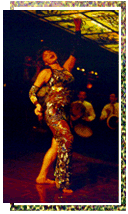 |
 |
 |
|
|||
|
The Mystique of Belly Dancing It's a Thursday night in Cairo, the Arab world's big night out, Friday being the Muslim Sabbath. Street vendors, hucksters, and shoeshine boys crowd the streets, all vying, it seems, for my wallet full of Egyptian pounds, but no chance. I'm saving my dough for the nightclubs, and I'm gonna need it. Cruising the belly dancing cabarets of Cairo ain't cheap, nor is it for early-to-bedders. Many of the good dancers don't hit the stage until one or two in the morning. As for the cover charges, well there aren't any, technically, but the drink minimums run anywhere from twenty five to fifty bucks a head. 
Harem Street is where many of the cabbies and hotel concierges will send you when you ask about belly dancing clubs. But Harem Street is strictly for tourists, a place to watch top-heavy, silicone enhanced amateurs bump and grind their way across the stage in sequined getups that highlight the flesh, which is what Harem Street shows tend to be about. But that's not real belly dancing. Sure, there's some bare skin involved, but belly dancing is more than just an oriental form of burlesque. It's a ritualistic fertility dance that dates back Pharoanic times, a folk custom known as Beladi dancing, a term we westerners bastardized into the seemingly apt description, belly dancing. To get a taste of the real thing, you have to hit the five star hotels, places like the Sheraton Cairo, where a willowy, auburn-haired young woman named Dalila performs on Thursday nights. Fairly new to the game, the professionally trained Dalila hopes to be as successful as some of her predecessors, belly dancing superstars like Fifi Abduh, Dina or Lucy, who rake in as much as six figures a year performing their art in nightclubs and at private parties and weddings. The Egyptians are the best belly dancers, Dalila tells me, because the music and the rhythm is in their blood. But it's a bloodline that's been thinned in recent years by threats of violence from Islamic fundamentalists who condemn belly dancing as a perversion. Such threats have forced some Egyptian dancers into early retirement, or dissuaded others from going into the profession.
Jasmina is a belly dancer at the Heliopolis Meridien.

But instead of shutting down the nightclubs, the controversy has actually opened the floodgates to a whole new generation of foreign belly dancers. Dancers like Jasmina, who hails from England, now dominate the stages of Cairo's nightclubs. As non-Muslims, these women aren't subject to the same kind of heat from the religious right as their Arab colleagues, and so on any given night, you're more likely to see a Russian, Argentinean, or even American dancer on the stage than you are an Egyptian. Still, the best are trained by Egyptians, says Jasmina, one of the city's most popular belly dancers. English or no, she certainly embodies all the mysteries of the orient when she performs. Her movements are fluid, erotic, alluring. At one moment, tense and quivering like tail of a rattlesnake, and the next as undulant as a wisp of smoke. Every muscle in her body, it seems, is in motion, yet in complete control. In the overall scheme of things, the belly plays only a bit part.
Jasmina stages a full-scale production, with supporting characters who wrap her in silk banners, spin her around and provide occasional comic relief. Other dancers like Dalila keep their shows simple, with few props other than perhaps a pair of finger cymbals to enhance the show. In the end, it's a matter of taste. Call it a serious art form, call it an adolescent male fantasy, call it what you like, belly dancing always has been and remains as much a part of the Egyptian mystique as the aroma of the spice market or the silent but enticing gaze of the Sphinx. In Cairo, I'm Tom Verde for The Savvy Traveler.
|
 | American Public Media Home | Search | How to Listen ©2004 American Public Media | Terms of Use | Privacy Policy |
